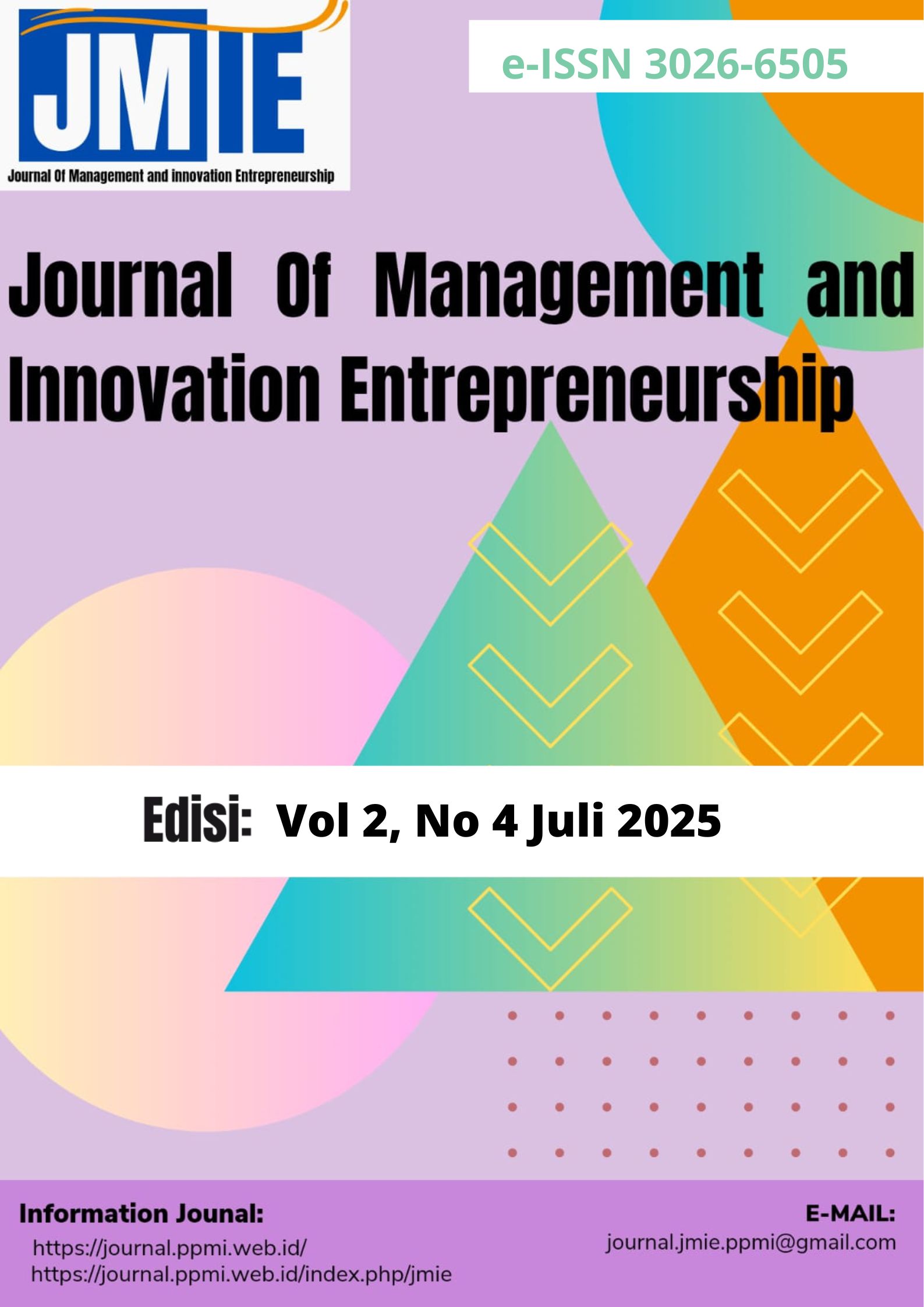FACTOR ANALYSIS OF WORK-LIFE BALANCE DETERMINANTS AMONG EMPLOYEES OF THE OFFICE OF WOMEN'S EMPOWERMENT AND CHILD PROTECTION IN KENDARI CITY
DOI:
https://doi.org/10.70248/jmie.v2i4.2770Keywords:
Personality, Demographics, Job Characteristics, Work Meaning, Family SupportAbstract
This study aims to analyze the factors that determine the work-life balance of female employees at the Office of Women’s Empowerment and Child Protection in Kendari City. The variables examined include personality traits, demographic characteristics, job characteristics, the personal meaning of work, and family support. The population of this study consists of all married female employees at the Kendari City Office of Women’s Empowerment and Child Protection, totaling 60 individuals. Due to the limited number of the population, a census approach was applied, whereby all members of the population also served as respondents. The analytical technique used is Exploratory Factor Analysis (EFA), assisted by the IBM SPSS Version 23 software application. The results of the study reveal that three main factors emerged from the factor analysis: job characteristics, personal meaning of work, and family support. Among these, the factor with the most significant influence is the personal meaning of work, indicating that the greater the perceived meaning of work for oneself, the more likely the employees are to maintain their dual roles as both professionals and homemakers. Conversely, family support was found to have the least influence, possibly due to its moderation by personality characteristics. In addition, external influences such as social status issues may also play a role in weakening the effect of family support on work-life balance
References
An, J., Zhu, X., Shi, Z., & An, J. (2024). A serial mediating effect of perceived family support on psychological well-being. BMC Public Health, 24(1), 940. https://doi.org/10.1186/s12889-024-18476-z
Apascaritei, P., & Elvira, M. M. (2022). Dynamizing human resources: An integrative review of SHRM and dynamic capabilities research. Human Resource Management Review, 32(4), 100878. https://doi.org/https://doi.org/10.1016/j.hrmr.2021.100878
Barakovic Husic, J., Melero, F. J., Barakovic, S., Lameski, P., Zdravevski, E., Maresova, P., Krejcar, O., Chorbev, I., Garcia, N. M., & Trajkovik, V. (2020). Aging at Work: A Review of Recent Trends and Future Directions. International Journal of Environmental Research and Public Health, 17(20). https://doi.org/10.3390/ijerph17207659
Bouwmeester, O., Atkinson, R., Noury, L., & Ruotsalainen, R. (2021). Work-life balance policies in high performance organisations: A comparative interview study with millennials in Dutch consultancies. German Journal of Human Resource Management, 35(1), 6–32. https://doi.org/10.1177/2397002220952738
Brough, P., Timms, C., Chan, X. W., Hawkes, A., & Rasmussen, L. (2020). Work–Life Balance: Definitions, Causes, and Consequences BT - Handbook of Socioeconomic Determinants of Occupational Health: From Macro-level to Micro-level Evidence (T. Theorell (ed.)). Springer International Publishing. https://doi.org/10.1007/978-3-030-31438-5_20
Cayrat, C., & Boxall, P. (2023). The roles of the HR function: A systematic review of tensions, continuity and change. Human Resource Management Review, 33(4), 100984. https://doi.org/https://doi.org/10.1016/j.hrmr.2023.100984
Cotič, L. P., Man, M. M. K., Soga, L. R., Konstantopoulou, A., & Lodorfos, G. (2025). Job Characteristics for Work Engagement: Autonomy, Feedback, Skill Variety, Task Identity, and Task Significance. Global Business and Organizational Excellence , 44(5), 75–85. https://doi.org/10.1002/joe.22295
Daly, M. (2021). Personality Traits and Social Structure BT - Macropsychology: A Population Science for Sustainable Development Goals (M. MacLachlan & J. McVeigh (eds.)). Springer International Publishing. https://doi.org/10.1007/978-3-030-50176-1_4
Eleonora Casandra Dobre. (2025). The Impact of Demographic Changes on HR Processes: A Highlight on Management of Multigenerational Workforce. China-USA Business Review, 24(1), 19–28. https://doi.org/10.17265/1537-1514/2025.01.002
Fassett, K. T., Wolcott, M. D., Harpe, S. E., & McLaughlin, J. E. (2022). Considerations for writing and including demographic variables in education research. Currents in Pharmacy Teaching and Learning, 14(8), 1068–1078. https://doi.org/https://doi.org/10.1016/j.cptl.2022.07.022
Gawande, R. (2024). WORK-LIFE BALANCE AND ITS IMPACT ON EMPLOYEES: NAVIGATING STRATEGIES FOR BETTER WORK-LIFE BALANCE AT WORKPLACE. 20, 130.
Gnepp, J., Klayman, J., Williamson, I. O., & Barlas, S. (2020). The future of feedback: Motivating performance improvement through future-focused feedback. PloS One, 15(6), e0234444. https://doi.org/10.1371/journal.pone.0234444
Gürler, G., Polat, F., & Özdemir, Y. (2022). A Proposal of Employee Life Cycle within the Context of Individual and Organization.
Haller, Max, Klösch, Beate, & Hadler, Markus. (2023). The Centrality of Work: A Comparative Analysis of Work Commitment and Work Orientation in Present-Day Societies. SAGE Open, 13(3), 21582440231192110. https://doi.org/10.1177/21582440231192114
Handelzalts, J. E., Kalfon-Hakhmigari, M., & Garthus-Niegel, S. (2024). Work-family conflict: emphasis on families in modern work environments. Journal of Reproductive and Infant Psychology, 42(2), 139–141. https://doi.org/10.1080/02646838.2024.2303870
Hill, P. L., & Edmonds, G. W. (2017). 3 - Personality development in adolescence (J. B. T.-P. D. A. the L. Specht (ed.)). Academic Press. https://doi.org/https://doi.org/10.1016/B978-0-12-804674-6.00003-X
Ibrahim, B. A., & Hussein, S. M. (2024). Relationship between resilience at work, work engagement and job satisfaction among engineers: a cross-sectional study. BMC Public Health, 24(1), 1077. https://doi.org/10.1186/s12889-024-18507-9
Jiang, Z., Hu, X., & Wang, Z. (2018). Career adaptability and plateaus: The moderating effects of tenure and job self-efficacy. Journal of Vocational Behavior, 104, 59–71. https://doi.org/https://doi.org/10.1016/j.jvb.2017.10.006
Kandler, C., Bratko, D., Butković, A., Hlupić, T. V., Tybur, J. M., Wesseldijk, L. W., de Vries, R. E., Jern, P., & Lewis, G. J. (2021). How genetic and environmental variance in personality traits shift across the life span: Evidence from a cross-national twin study. Journal of Personality and Social Psychology, 121(5), 1079–1094. https://doi.org/10.1037/pspp0000366
Kpolovie, P. (2017). STATISTICAL ANALYSIS WITH SPSS FOR RESEARCH.
Laguía, A., Topa, G., Pocinho, R. F. D. S., & Fernández Muñoz, J. J. (2024). Direct effect of personality traits and work engagement on job crafting: A structural model. Personality and Individual Differences, 220, 112518. https://doi.org/https://doi.org/10.1016/j.paid.2023.112518
Li, J., Kaltiainen, J., & Hakanen, J. J. (2024). Job boredom as an antecedent of four states of mental health: life satisfaction, positive functioning, anxiety, and depression symptoms among young employees – a latent change score approach. BMC Public Health, 24(1), 907. https://doi.org/10.1186/s12889-024-18430-z
Li, W., Zhang, J., Zhang, Y., & Xia, Y. (2024). Striving for family in the workplace: how family functioning facilitates family motivation and compensates for job autonomy. Current Psychology, 43(32), 26427–26437. https://doi.org/10.1007/s12144-024-06303-y
Ly, B. (2024). Inclusion leadership and employee work engagement: The role of organizational commitment in Cambodian public organization. Asia Pacific Management Review, 29(1), 44–52. https://doi.org/https://doi.org/10.1016/j.apmrv.2023.06.003
Martela, F., Gómez, M., Unanue, W., Araya, S., Bravo, D., & Espejo, A. (2021). What makes work meaningful? Longitudinal evidence for the importance of autonomy and beneficence for meaningful work. Journal of Vocational Behavior, 131, 103631. https://doi.org/https://doi.org/10.1016/j.jvb.2021.103631
Men, L. R., & Yue, C. A. (2019). Creating a positive emotional culture: Effect of internal communication and impact on employee supportive behaviors. Public Relations Review, 45(3), 101764. https://doi.org/https://doi.org/10.1016/j.pubrev.2019.03.001
Monje-Amor, A., Xanthopoulou, D., Calvo, N., & Abeal Vázquez, J. P. (2021). Structural empowerment, psychological empowerment, and work engagement: A cross-country study. European Management Journal, 39(6), 779–789. https://doi.org/https://doi.org/10.1016/j.emj.2021.01.005
Müller, Michal, & Kubátová, Jaroslava. (2025). A systematic review of managerial burnout and personal crisis: Navigating the interplay of individual, organizational, and environmental factors. German Journal of Human Resource Management, 23970022251315650. https://doi.org/10.1177/23970022251315650
Orellana, L., Schnettler, B., Miranda-Zapata, E., Saracostti, M., Poblete, H., Lobos, G., Adasme-Berríos, C., Lapo, M., & Concha-Salgado, A. (2023). Job satisfaction as a mediator between family-to-work conflict and satisfaction with family life: a dyadic analysis in dual-earner parents. Applied Research in Quality of Life, 18(1), 491–520. https://doi.org/10.1007/s11482-022-10082-8
Peleg, O., & Peleg, M. (2025). Is Resilience the Bridge Connecting Social and Family Factors to Mental Well-Being and Life Satisfaction? Contemporary Family Therapy, 47(1), 87–101. https://doi.org/10.1007/s10591-024-09707-x
Rasool, S. F., Wang, M., Tang, M., Saeed, A., & Iqbal, J. (2021). How Toxic Workplace Environment Effects the Employee Engagement: The Mediating Role of Organizational Support and Employee Wellbeing. International Journal of Environmental Research and Public Health, 18(5). https://doi.org/10.3390/ijerph18052294
Ryan, R. M., & Deci, E. L. (2020). Intrinsic and extrinsic motivation from a self-determination theory perspective: Definitions, theory, practices, and future directions. Contemporary Educational Psychology, 61, 101860. https://doi.org/https://doi.org/10.1016/j.cedpsych.2020.101860
Saprilliani, Ginting, R., & Girsang, E. (2018). Faktor-Faktor Yang Mempengaruhi Angka Rujukan Pasien Peserta Kartu Indonesia Sehat (KIS) Di Puskesmas Tanah Tinggi Kecamatan Binjai Timur Kota Binjai Tahun 2018. Jurnal Kesehatan Masyarakat Dan Lingkungan Hidup, 1(1), 1–15. http://www.fao.org/3/I8739EN/i8739en.pdf%0Ahttp://dx.doi.org/10.1016/j.adolescence.2017.01.003%0Ahttp://dx.doi.org/10.1016/j.childyouth.2011.10.007%0Ahttps://www.tandfonline.com/doi/full/10.1080/23288604.2016.1224023%0Ahttp://pjx.sagepub.com/lookup/doi/10
Sesen, H., & Ertan, S. S. (2023). Does Organizational Tenure Matter? The Relationship between Perceived Overqualification and Extra-Role Behaviours. Employee Responsibilities and Rights Journal, 35(1), 77–94. https://doi.org/10.1007/s10672-022-09403-8
Smollan, R. K., & Mooney, S. K. (2024). The bright side and dark side of performance expectations: the role of organizational culture and the impact on employee performance and wellbeing. International Studies of Management & Organization, 54(3), 218–237. https://doi.org/10.1080/00208825.2024.2320580
Sulaiman, A. A. (2024). Relationships between self-efficacy , autonomy , employee engagement , and performance in Nigerian public sector organizations. 16(4), 1188–1204.
Sun, H., Wang, S., Zhang, W., & Sun, L. (2024). Do conscientious employees have a high level of work engagement? The roles of presenteeism and perceived organizational support. Frontiers in Psychology, 15, 1485025. https://doi.org/10.3389/fpsyg.2024.1485025
Tang, W.-G., & Vandenberghe, C. (2020). Is affective commitment always good? A look at within-person effects on needs satisfaction and emotional exhaustion. Journal of Vocational Behavior, 119, 103411. https://doi.org/https://doi.org/10.1016/j.jvb.2020.103411
Tanjung, B. N. (2020). Human Resources (HR) In Education Management. Budapest International Research and Critics in Linguistics and Education (BirLE) Journal, 3(2), 1240–1249. https://doi.org/10.33258/birle.v3i2.1056
Tett, R. P., & Fisher, D. M. (2021). Chapter 41 - Personality dynamics in the workplace: An overview of emerging literatures and future research needs (J. F. B. T.-T. H. of P. D. and P. Rauthmann (ed.)). Academic Press. https://doi.org/https://doi.org/10.1016/B978-0-12-813995-0.00041-8
Törnroos, M., Jokela, M., & Hakulinen, C. (2019). The relationship between personality and job satisfaction across occupations. Personality and Individual Differences, 145, 82–88. https://doi.org/https://doi.org/10.1016/j.paid.2019.03.027
Ward, S. J., & King, L. A. (2017). Work and the good life: How work contributes to meaning in life. Research in Organizational Behavior, 37, 59–82. https://doi.org/https://doi.org/10.1016/j.riob.2017.10.001
Widiastuti, T., Al-shami, S. A., Mawardi, I., Zulaikha, S., Haron, R., Kasri, R. A., Mustofa, M. U. Al, & Dewi, E. P. (2024). Capturing the barriers and strategic solutions for women empowerment: Delphy analytical network process. Journal of Open Innovation: Technology, Market, and Complexity, 10(3), 100345. https://doi.org/https://doi.org/10.1016/j.joitmc.2024.100345
Zaitouni, M., Hewapathirana, G., Mostafa, M., Al Hajj, R., & ElMelegy, A. R. (2024). Work-life balance: A landscape mapping of two decades of scholarly research. Heliyon, 10(14), e34084. https://doi.org/https://doi.org/10.1016/j.heliyon.2024.e34084
Zhang, Y., & Liu, S.-M. (2022). Balancing employees’ extrinsic requirements and intrinsic motivation: A paradoxical leader behaviour perspective. European Management Journal, 40(1), 127–136. https://doi.org/https://doi.org/10.1016/j.emj.2021.11.008




















